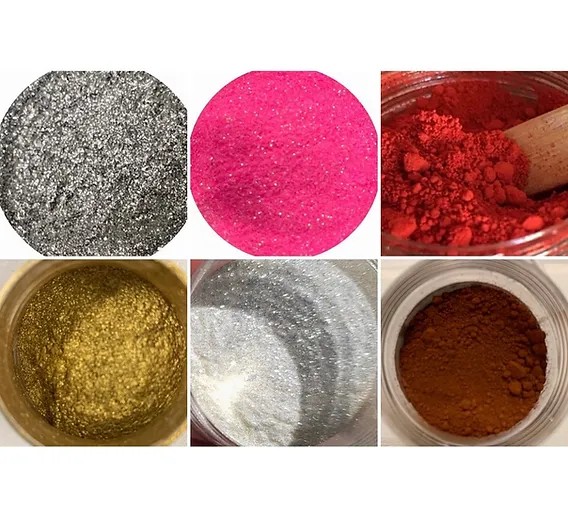If you’re exploring the world of DIY crafts, soap making, or cosmetics, you’ve likely encountered both mica powder and pigment powder as popular colourants. While they may appear similar at first, each has unique properties and applications that can dramatically affect your final product. This guide will help you understand the key differences between mica powder and pigment powder so you can choose the right one for your project.
What is Mica Powder?
Mica powder is a fine powder made from natural mica minerals, known for its shimmering, reflective qualities. Mica’s sparkle comes from its layered structure, which reflects light to create a radiant, metallic effect. Available in a variety of colours, mica powder is often combined with pigment to enhance its colour vibrancy.
Mica powder is widely used in projects where a touch of shimmer is desired, such as in soap making, cosmetics, resin crafts, and candle making. It provides a subtle, reflective finish, ideal for adding a luxurious effect without overpowering the product with intense colour.
What is Pigment Powder?
Pigment powder, unlike mica, is made up of fine, opaque colour particles that don’t shimmer or sparkle. Pigments can be derived from natural sources or created synthetically, offering solid, intense colours without the reflective properties of mica.
Pigment powder is versatile and commonly used in applications where a strong, matte colour is needed. It’s popular in acrylic paints, pottery glazes, nail polish, and even cosmetics for creating vibrant colours, such as in lipstick or blush. Pigment’s opacity ensures the colour will remain bold and consistent, even in dense materials.
Key Differences Between Mica Powder and Pigment Powder
Appearance
Mica powder is known for its shimmery, translucent finish, which adds a soft, lustrous glow to projects. In contrast, pigment powder provides a solid, opaque colour without any reflective quality, making it ideal for projects that require a bold, matte finish.
Colour Intensity
Pigment powder generally offers stronger, more vivid colours than mica powder. While mica can add a subtle sheen, pigment powder delivers bold, consistent colour. This makes pigments more suitable for applications where intense colour payoff is needed, such as in paints and certain cosmetics.
Application Suitability
Each powder type shines in different applications. Mica powder is best suited for projects that benefit from shimmer and depth, such as soap making, candle decorating, and resin crafts. Pigment powder is a better choice when a solid, opaque colour is needed, like in pottery, nail polish, or items with high coverage needs.
Mixing Requirements
Pigment powder tends to be thicker and requires more thorough mixing to prevent clumping, particularly in liquids. Mica powder, while easier to blend, may need dispersing in oil or other mediums to prevent clumping in soap or resin projects. Ensuring smooth distribution is essential for both powders to achieve an even finish.
Choosing the Right Powder for Your Project
For Soap Making
For those making soap, mica powder can add a beautiful shimmer, especially in transparent melt-and-pour soaps. Pigment powder, on the other hand, creates more solid colours, ideal for achieving bold colour in cold-process soap. Choose mica for a translucent, glittery effect and pigment for a vibrant, solid hue.
For Resin Crafts
In resin, mica powder can create stunning metallic effects, ideal for art pieces, jewellery, and coasters. Pigment powder provides an opaque finish, making it perfect for designs requiring a strong colour that won’t show the transparency of resin.
For Cosmetics
In cosmetics, both powders have unique applications. Mica powder adds shimmer to highlighters, eyeshadows, and lip glosses, while pigment powder is better suited for bold products like lipstick, nail polish, or blush, where strong, opaque colour is desired.
Tips for Using Mica and Pigment Powders Together
For projects where both shimmer and bold colour are desired, mica and pigment powders can be blended to create unique effects. When combining, start with a small amount of each powder to control the balance between shimmer and opacity. A bit of pigment powder can enhance the depth of mica, while mica can add a lustrous finish to the solid base colour of pigment. Be sure to mix well to achieve even colour distribution without overpowering the other’s effect.
In Summary
Mica powder and pigment powder each offer distinct benefits, from mica’s shimmering, translucent finish to pigment’s intense, opaque colour. By understanding the differences and knowing how to choose the right powder, you can elevate your DIY projects, cosmetics, or craft creations with the perfect colour effect. Experiment with both powders and discover which best suits your unique vision. Happy crafting!

